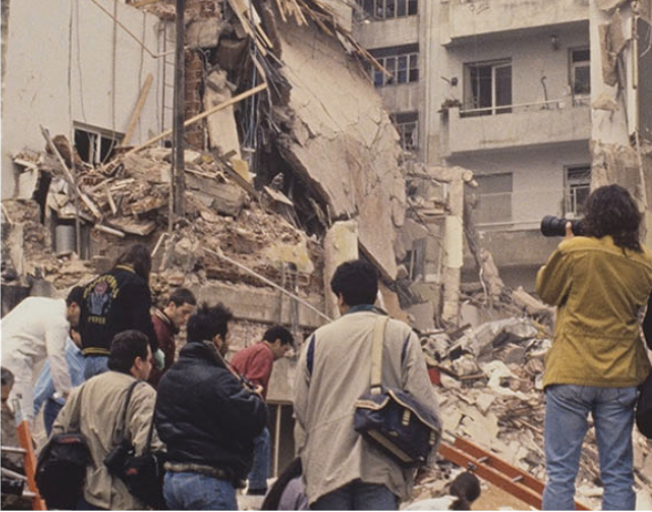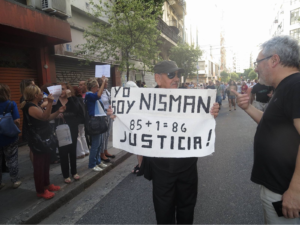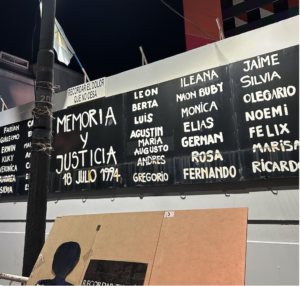30th anniversary of the AMIA attack: Argentina’s path to justice

A few weeks ago, Argentina commemorated the 30th anniversary of the country’s deadliest terrorist attack. On July 18, 1994, a van containing a bomb exploded at the entrance of the Asociación Mutual Israelita Argentina (AMIA), a Jewish community center located in a densely populated neighborhood in Buenos Aires, injuring over 300 and taking the lives of 85 people. In the decades leading up to the attack, Argentina had become home to one of the largest Jewish communities of the world. According to a 1994 New York Times article, a community member of the AMIA cried out at the site of the attack: “how can we keep going here, if there is no safety?” Thirty years later, such sentiment is widely shared – without justice brought to its perpetrators, and through events since, the attack has emphasized the Argentine government’s betrayal of its people.
Due to the lack of forensic evidence, the identity of the van’s driver was subject to much speculation after the attack, but the work of investigators advanced the search for the perpetrators. Most notably, Alberto Nisman, an Argentine prosecutor, began leading the investigations in 2004. In a report of 113,600 pages, Nisman emphasized DNA discoveries that identified the potential suicide-bomber as Ibrahim Hussein Berro, an active Hezbollah militant at the time of the attack. Moreover, according to an indictment, “the decision to carry out the AMIA attack was made […] by the highest officials of the Islamic Republic of Iran at the time, and these officials instructed Lebanese Hezbollah – a group that has historically been subordinated to the economic and political interests of the Tehran regime – to carry out the attack”. The document also accused Hezbollah of developing operations across Latin America, and Berro of entering Argentina through a cell of activity located in the Triple Frontier.
The investigation eventually shone light on a pattern of corruption and complicity within the Argentine government. Nisman claimed that the justice process, during the years following the attack, had been hindered by former President Cristina Kirchner who ruled the country from 2007 to 2015, and her Foreign Minister Héctor Timerman. The accusation asserted that Kirchner and Timerman had agreed to conceal Iran’s role in the attack in exchange for a supply of oil sent to Argentina. However, on January 18, 2015, only a single night before he was scheduled to present his case before the Congress, Nisman was found shot in his apartment. Forensic evidence provided different accounts, with some ruling suicide and others death-by-homicide. However, a recent 2018 ruling by the Federal Court of Appeals has proclaimed it to be the latter, and also accused the initial investigation of negligence. From the onset, the investigation was hindered by a carelessness that impeded the victim’s right to the truth, a betrayal in itself.
Although Nisman’s death and the bombing occurred more than two decades apart, both events were characterized by the state’s complicity in the evasion of justice; Nisman has since been termed the “86th victim” of the AMIA attack. After the country erupted into mass protest in 2015, politician Martín Lousteau told the New York Times: “with Nisman, it’s like all the rot from the bad political practices has surfaced in the sewers of the building where he died”. The AMIA attack and Nisman’s death have unsurprisingly become symbols of the violations that emerge from systems of high corruption and impunity.
In fact, an attendee of the 2015 manifestation in Buenos Aires, 28-year-old Guillermina Sutter-Schneider, further told La Nacíon: “I cannot believe that they are running over the Republic like this. I came for the future generations. They killed this guy [Nisman]… the government should have protected him”. For such citizens, Nisman’s death has implications for the entire country, current and future generations alike. Argentina has had a volatile relationship with democracy for centuries – its history has been witness to countless corruption scandals, a frequent failure to put those responsible for crime behind bars, and even a military dictatorship between 1976 and 1983 characterized by impunity laws. This pattern of violence and a failed justice system is the Argentine government’s ultimate betrayal of its fundamental duty – the protection of its people. The circumstances surrounding the AMIA bombing were a manifestation of this status quo.

In recent years, however, there have been attempts to amend such injustices. In 2017, a federal judge requested for the Senate to allow for Kirchner’s incarceration under the charge of treason. Since Kirchner had also been an elected senator since 1994 and thus possessed immunity from detention, the request called for this parliamentary indemnity to be lifted. The indictment was based on Nisman’s own suspicions that Iranian oil was leveraged as a tool for impunity, but also cited a 2013 memorandum of understanding between Iran and Argentina to jointly investigate the terrorist attack. Kirchner rejected all accusations and claimed that the memorandum was signed in order to advance the search for the perpetrator; David Harris from the American Jewish Committee likened this to “asking Nazi Germany to help establish the facts of Kristallnacht”. Moreover, she accused Mauricio Macri, the political opponent who succeeded her presidency, of collaborating with judges to wrongfully charge her, thus creating a distraction from his own contentious labor reforms.
Later, in 2021, a three-judge panel absolved Kirchner from going to trial by ruling that no crime had been committed, despite the Iranian-Argentine memorandum having been voided by a court during Macri’s administration. This decision was met with much controversy, including a discussion by lawyer Tomás Farini Duggan, a representative of the victims’ families, which brought into question the impartiality of the panel. Jorge Knoblovits of the Delegación de Asociaciones Israelitas Argentinas stated: “of course we don’t agree with this decision; in order to determine whether there was a crime or not, there must be a trial first”. Once again, the search for justice reached a dead end.
Then, in April of this year, a ruling from Argentina’s Federal Criminal Cassation Court declared that Hezbollah, acting under the funding and leadership of Iran, had indeed led the attack. This proclamation, which deemed the Iranian regime a ‘terrorist state’, urges the Argentine state to seek the involvement of international courts and calls for the arrest of Iranian officials, such as Interior Minister Ahmad Vahidi. However, Dr. Fishel Szlajen, a former director at the AMIA, was less than optimistic: “a ruling is better than continued judicial silence… [but] after three decades when the intellectual and material authors have lived in freedom, aging peacefully, it is not cause for celebration”. Szlajen reflects the growing demand for concrete progress in Argentina and for perpetrators to be held responsible, which the justice system has failed to achieve three decades following the atrocity. Although steps to place international pressure on Iran and Hezbollah have been taken by Argentina and other Latin American states in the past few years, it is important that this year’s ruling yields more than an empty promise. To reflect the interests of its people, the Argentine government must seek justice.
Hence, this year, Argentina mourns the 85 lives that were taken in the attack and reflects on the painful reminder of persisting systems of impunity. Despite this year’s new development in the case, there is still much work to be done by the Argentine government to reverse its past failings. After the bombing, the AMIA was rebuilt and stands in the same location as before, but with an addition: painted on a wall at the entrance is a list of the victims. At the center, written in bold, white letters, is a message that reflects the demands of the nation; a call for “MEMORY and JUSTICE”.

Featured Image: “Atentado a la AMIA” by www.argentina.gob.ar is licensed under CC BY 4.0.
Edited by Aliyah Yagboyaju
